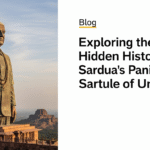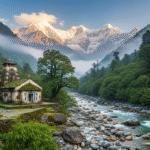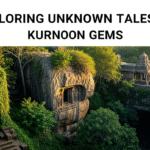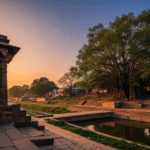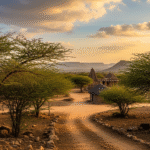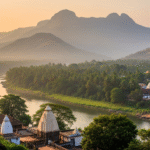Before India got its freedom, the British East India Company controlled a big area. It was called Tirhut and was huge, covering 5,053 square miles! This area contains West Champaran. It is famous for a big moment in history where people fought without violence. But there’s more to West Champaran than just its well-known political history.
It has been important since ancient times and saw big changes when Britain ruled. Yet, many people are just now learning its secrets. These secrets show us more about Indian history.
The story of West Champaran is full of myths and hard facts. It goes from ancient times to when Gandhi taught about fighting with peace. There’s a lot of research out there. For example, the “History of Tirhut” helps us learn about this area. Each new discovery tells us more about West Champaran.
Key Takeaways
- The district of West Champaran holds a pivotal historical role that spans back to the ancient Tirhut civilization.
- Publications have gradually peeled back the layers of time, revealing the mysterious facts about West Champaran.
- Through the nonviolent Satyagraha movement, the region contributed significantly to India’s freedom struggle.
- Administrative developments during the East India Company era reshaped the historical landscape of the region.
- The ongoing historical research provides deeper insights into the cultural underpinnings and developmental milestones of the area.
- Historical texts play a crucial role in educating us about the hidden chapters of West Champaran’s past.
The Enigmatic Past: Origins of Tirhut and Mithila
Tirhut, also called Mithila, is a key ancient civilization in West Champaran. It shaped the Indian subcontinent’s history. It was mostly unknown until the 16th century when scholars started to study its history. Shyam Narayan Singh’s book, “History of Tirhut: From the Earliest Times to The End of the Nineteenth Century,” helps us understand its impact on Indian history.
Distinct Civilizations and Submerged Histories
In West Champaran, Tirhut reveals its rich history. It tells us about early human settlements and advanced governance systems. This area shows how its diverse civilization helps us know more about South Asian history.
Legends and Mythology: The Cultural Backbone
Mithila’s culture is filled with legends and myths. These stories build its cultural identity. Works like the “Riaz-i-Tirhut” and “Mithila Darpan” are crucial. They mix mystic and historical stories, showing Tirhut’s amazing heritage.
These legends show how the divine and everyday life were linked. They influenced everything from social customs to religious festivals.
| Cultural Artifacts | Description | Historical Period |
|---|---|---|
| Ivory Seals | Featuring intricate carvings used for administrative purposes | 4th Millennium BCE in Hindu Civilizational Contexts |
| Indus Script Inscriptions | Linked to metal trade, providing evidence of early economic structures | 3000-2500 BCE |
| Yūpa Brick from Binjor | Indicative of ritualistic ceremonies in ancient societies | Around 2600 BCE |
The findings in West Champaran teach us more about ancient lives. They show Tirhut’s role in ancient trades and cultures. With careful preservation and study, Mithila’s mysterious past continues to be important for India’s history today.
Mysterious facts about West Champaran
West Champaran sits in Bihar, India, wrapped in mystery. Few records exist, showing its deep roots in India’s history. Yet, many mysterious facts about West Champaran are still unknown.
The area’s history is full of enigmatic discoveries in West Champaran. Ancient ruins and oral stories hint at forgotten times. West Champaran’s past is a mix of known and unknown stories.
Even though not much is written about it, this district is key to India’s culture. The mysteries here are tied to its past and its people’s spirit.
| Discovery | Location | Significance |
|---|---|---|
| Ancient Coins | Near Gandak River | Indicates historical trade routes and old civilizations. |
| Manuscripts | Local village houses | Shed light on the social and cultural history during the medieval period. |
| Archaeological ruins | Harinagar | Possible remnants of ancient religious sites or settlements. |
Every site and artifact in West Champaran could reveal more about Indian history. Uncovering these mysterious facts about West Champaran and finding enigmatic discoveries will enrich India’s history.
The British Influence: Sarkar Tirhut’s Transformation
The story of West Champaran changed a lot under the British. It was part of Bihar, called Sarkar Tirhut then. The area saw big changes, not just in politics, but also in how people lived and worked. These changes affect the area even today.
Administrative Reforms and Cultural Shifts
The British rule brought big shifts in how West Champaran was run. The East India Company divided Bihar into sarkars. This made the government work better and helped the British control things smoothly.
East India Company’s Legacy: A New Social Order
Society in West Champaran changed a lot because of the East India Company. The British changed land boundaries and controlled who had power. They set up a new way of living that matched their own rules and ideals.
| Year | Event | Impact on West Champaran |
|---|---|---|
| 1765 | East India Company takes administration of Subah Bihar | Introduction of British administrative structures |
| 1922 | Publication of “History of Tirhut” | Documented the comprehensive history and transformation under British rule |
This table shows important events in West Champaran’s history during British rule. These events changed the area’s land and people. The British influence shaped what West Champaran is today.
Birth of Satyagraha: West Champaran and Gandhi’s Movement
The Birth of Satyagraha started in the early 20th century. It is based on nonviolent resistance, an idea from Mahatma Gandhi. This movement began in West Champaran. It was Gandhi’s first stand against British unfairness using peace.
In 1917, Gandhi went to Champaran because of the troubled indigo farmers. This visit began the Satyagraha movement in India. In West Champaran, Gandhi used fasting, boycotting, and peaceful protests. His goal was to help those being hurt and to fight unfair treatment.
The Champaran movement was a big win. It started a trend of peaceful resistance in India. This helped in the fight for freedom from the British.
Gandhi first thought of Satyagraha in South Africa in 1906. Then, he led many campaigns. These efforts brought together many people. They all supported Gandhi’s peaceful ways.
- 1917: The start of the first Satyagraha in West Champaran.
- 1920–1922: The Noncooperation Movement showed the people’s disapproval of British rule.
- 1930: The Salt March protested against the salt tax.
- 1942: The Quit India Movement really pressured the British to leave India.
Gandhi’s nonviolent methods were key in changing India’s fight for freedom. Because of them, the British left in 1947.
| Event | Year | Impact |
|---|---|---|
| Champaran Satyagraha | 1917 | Triggered wider nationalistic movements |
| Noncooperation Movement | 1920 – 1922 | Shook the foundations of British colonial rule in India |
| Salt March | 1930 | Galvanized masses against the Salt Tax |
| Quit India Movement | 1942 | Direct action for Indian independence, leading to end of British rule |

The legacy of West Champaran and Birth of Satyagraha is crucial. It shows Gandhi’s successful peaceful resistance. This spirit of nonviolent fight still inspires civil rights movements worldwide.
Lost Literature of West Champaran: Rediscovering Ancient Texts
West Champaran has a history rich with ancient writings. This area is key in the historiography of Mithila. It has produced many texts that show its culture and history. Now, people are finding these important works once thought to be lost.
Renaissance of Mithila’s Historiographic Pioneer
The revival of Shyam Narayan Singh’s “History of Tirhut” is central to these efforts. This book is more than a hundred years old. It helps researchers understand ancient Mithila. The Maharajadhiraja Kameshwar Singh Kalyani Foundation has republished it. They want its stories and lessons to last for more years.
Reclaiming Heritage: Republishing the Rare and Old
The efforts to bring back heritage include more than just scholarly works. They also focus on a wide range of cultural writings. By republishing old manuscripts, groups are making sure West Champaran’s history is kept alive. They want it to be known by the public and scholars all over the world.
In the texts being brought back, centuries-old stories are gaining new life. They offer fresh views on the historiography of Mithila. This work does more than add to our knowledge of the past. It makes sure West Champaran’s rich history is remembered and studied today.
- Ensuring access to original texts and translations
- Engaging with local and global scholars in collaborative research
- Organizing seminars and exhibitions featuring these ancient texts
Thanks to these efforts, West Champaran’s literary past is being saved and celebrated. It helps people today appreciate and understand this area’s important history.
Art and Architecture: The Hidden Wonders of West Champaran
West Champaran is full of hidden artistic wonders. It’s packed with culture and history. This area might not be well-known, but it has lots of architectural beauty. Its buildings and art tell the story of its local design history.

Unknown Masterpieces and Forgotten Creations
In West Champaran, there are many monuments and art pieces. They show how the region has changed over time. You can find beautiful temples and big colonial houses here. But, many people don’t know about these hidden artistic wonders.
Influence of Different Eras on Local Design
The buildings in West Champaran show many styles. This mix comes from many different time periods. Ancient dynasties, medieval times, and the British era all added something special. This shows the area’s history of change and creativity.
It’s important to keep these stories of architecture alive. They help us enjoy West Champaran’s culture. They also teach us about India’s history.
| Feature | Details | Historical Influence |
|---|---|---|
| Ancient Temples | Intricate carvings, sandstone walls | Indian dynastic architecture |
| Colonial Mansions | Elegant facades, large verandas | British colonial era |
| Local Houses | Use of local materials, traditional designs | Indigenous tribal influences |
The beauty in West Champaran’s buildings is amazing. They show us who we are. They make West Champaran an important part of West Champaran’s art and architecture.
The Regional Delicacy: Culinary Secrets of West Champaran
West Champaran lies in India’s northwest and offers a plate full of stories and tastes. The regional delicacies of West Champaran are more than just food. They are a celebration of the area’s history and lively culture, handed down through time.
West Champaran’s culinary secrets are famous for their real taste and traditional touch. They attract both food lovers and historians. You’ll find both savory and sweet dishes. Each dish shows the careful preparation and local ingredients of this area.
- Thekua: This traditional snack is part of religious ceremonies and uses wheat flour, jaggery, and ghee. It’s not only delicious but important during Chhath Puja for its cultural value.
- Jhor Bhaat: A spicy, tangy rice dish using fermented bamboo shoot. It showcases the local flavors and suits the regional taste.
- Sattu Paratha: A hearty and healthy breakfast choice. It’s made with roasted gram flour (sattu), herbs and spices. These are then stuffed into wheat dough and cooked in a pan.
The food in West Champaran goes beyond just eating. It’s closely linked with the region’s culture and celebrations. These dishes are part of a historic story of their own.
| Dish | Main Ingredients | Associated Festival/Event |
|---|---|---|
| Thekua | Wheat flour, jaggery, ghee | Chhath Puja |
| Jhor Bhaat | Rice, bamboo shoots, mustard oil | Local harvest celebrations |
| Sattu Paratha | Roasted gram flour, spices | Everyday breakfast |
Looking into West Champaran’s culinary secrets lets you into the region’s heart and soul. You see the deep link between its history and the regional delicacies of West Champaran. Each dish is not just flavorful but tells a story. They help keep the area’s unique cultural heritage alive.
Dr. Ramanand Jha: A Scholarly Beacon in Historical Research
Dr. Ramanand Jha changed how we see West Champaran’s history. His work has made us all understand more. It also showed us new ways to explore academically. His studies highlight the change from sarkar rule to when West Champaran started governing itself.
From Sarkar to Self-Governance: A Professor’s Insight
Starting as a lecturer and becoming a professor, Dr. Jha has taught much about West Champaran. He looked deeply into how governance and society changed. His detailed work has been a guiding light for others interested in Bihar and its place in India’s story.
Unveiling Academic Contributions to West Champaran’s History
Dr. Jha collected lots of important information in his works. This has been a big help to historians and researchers. These works cover many topics and show West Champaran’s multiple stories. Dr. Jha’s approach helps future scholars understand West Champaran’s rich history better.
FAQ
What are some mysterious facts about West Champaran?
West Champaran is full of secrets. It’s important because of its role in Indian history, the Satyagraha movement, and its ancient Tirhut civilization roots. Legends and myths surround its past. This makes it very interesting to learn about.
Can you share information about the origins of Tirhut and Mithila?
Tirhut, also called Mithila, is a very old area that has greatly affected India’s history. Stories of Mithila go back to texts from the 16th century. But, its remarkable history starts even before that.
What is the cultural backbone of West Champaran?
In West Champaran, culture is built on old stories and myths. Books like “Riaz-i-Tirhut” and “Mithila Darpan” keep its rich culture and religious ideas alive. These have helped shape Indian civilization.
How did British influence transform Sarkar Tirhut?
The East India Company brought big changes to Sarkar Tirhut. They changed its boundaries and the way it was run. These changes affected its people and its way of life a lot.
How did West Champaran contribute to the birth of Satyagraha?
Mahatma Gandhi started his first Satyagraha in West Champaran. He inspired the people to fight the British with nonviolent ways. This was based on India’s old philosophies and changed India’s fight for freedom.
What efforts are being made to rediscover the lost literature of West Champaran?
People are working to bring back old texts about the area’s history. The Maharajadhiraja Kameshwar Singh Kalyani Foundation is very important in this work. They help keep important books, like “History of Tirhut,” available.
What are the hidden wonders of West Champaran’s art and architecture?
The art and buildings of West Champaran mix many styles from different times. Rediscovering these treasures shows the area’s rich cultural history.
What are some of the culinary secrets of West Champaran?
West Champaran’s food tells stories of its past. Old recipes show the local way of life. But, there’s still a lot to discover about these traditions.
Who is Dr. Ramanand Jha and what is his contribution to West Champaran’s history?
Dr. Ramanand Jha is a researcher whose work explains how West Champaran changed to self-rule. His studies and work in the community help us understand the area’s complex history better.

